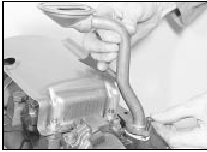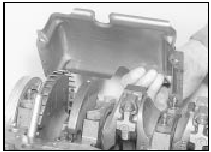Pistons and connecting rods - removal and refitting
Note: New connecting rod bolts and a new oil pick-up pipe gasket must be used on refitting.
Removal
1 Remove the sump and the cylinder head.
2 Unscrew the two securing bolts, and remove the oil pick-up pipe (see illustration).

29.2 Removing the oil pick-up pipe
Recover the gasket.
3 Unscrew the four securing nuts, and withdraw the oil baffle from the studs on the main bearing caps (see illustration).

29.3 Withdrawing the oil baffle
4 Proceed as described in Chapter 2, Part A, Section 32, paragraphs 2 to 5.
Refitting
5 Proceed as described in Chapter 2, Part A,
Section 32, paragraphs 6 to 13, noting the
following points:
6 Take note of the orientation of the bearing
shells during dismantling, and ensure that
they are fitted correctly during reassembly.
7 When fitting the pistons, ensure that the arrow on the piston crown and the letter “F” on the face of the connecting rod are pointing towards the front of the engine.
8 Use new connecting rod bolts on reassembly, and before fitting, oil the threads and the contact faces of the bolts. Tighten the bolts in the three stages given in the Specifications at the beginning of this Chapter.
9 Refit the oil baffle, and tighten the securing nuts.
10 Clean the mating faces of the cylinder block and the oil pick-up pipe, and refit the pick-up pipe using a new gasket.
11 Refit the cylinder head and the sump.
See also:
Cooling, heating and ventilation systems
The cooling system is of the pressurised pump-assisted thermo-syphon
type. The system consists of the radiator, water pump, thermostat, electric
cooling fan, expansion tank and associated hoses. ...
Carburettor overhaul - general information
Faults with the carburettor are usually
associated with dirt entering the float
chamber and blocking the jets, causing a
weak mixture or power failure within a certain
engine speed range. If this ...
Ignition systems
The ignition system is divided into two circuits, low tension
(primary) and high tension (secondary). The low tension circuit consists of the
battery, ignition switch, primary coil windings and th ...
